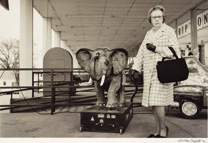A Turbulent Era Captured by
Three Masters of American Photography
Garry Winogrand (1928–1984) was born in New York City and began
photographing during a stint in the Army Air Force (1946–47). After
studies at City College of New York, Columbia University, and the New
School for Social Research, he became a commercial photographer, working
for several agencies. His photographs were exhibited for the first time
in 1955 in Family of Man at the Museum of Modern Art, where he returned
in 1969 with a solo exhibition. Winogrand’s essential subject matter was
the American street, and he had a particular eye for juxtaposing the
familiar and the peculiar, creating wide-angled or tilted shots that
appear to be casual quick takes, but are in fact densely composed and
layered with meaning. He moved to Los Angeles in 1978 and made this city
his subject until his death in 1984.
William Eggleston (b. 1939), who was raised in Mississippi, settled in
Memphis, Tennessee, in the 1960s. He acquired a Leica camera as a
teenager, and after studies at three different universities, decided
that photography, not academics, was his destiny. Though his early
black-and-white photographs, including those in the exhibition, are less
well known than his subsequent color images, they prefigure his later
works in many ways. Eggleston uses the subject matter of the typical
American “snapshot”-bland rooms and houses, bleak lawns, empty street
intersections, people in stiff and self-conscious poses - and forces
viewers to see these seemingly banal scenes in new ways This is the
first exhibition of black-and-white pictures by a photographer better
known for his color work. Since his solo exhibition at the Museum of
Modern Art (William Eggleston’s Guide, 1976), he has had numerous
exhibitions of his color photographs, including William Eggleston and
the Color Tradition at the Getty (October 1999–January 2000).
Diane Arbus (née Nemerov, 1923–1971) was one of three children born to a
creative and affluent New York family. She was introduced to photography
by her husband Allan Arbus, and both worked as fashion photographers
from the early 1940s through the late 1950s. Arbus, however, disliked
the artificial world of fashion shoots, and as her marriage
disintegrated, she began to pursue her own photographic interests. Her
most noted work deals with people on the streets and at the margins of
society. Her photographs of carnival freaks, transvestites, strippers,
nudists, and the mentally ill are direct, confrontational, and often
disturbing. But equally unsettling are her images of “normal” suburban
families, wealthy Fifth Avenue matrons, and New York conventioneers.
Even Sleeping Beauty’s castle at Disneyland, the quintessential sunlit
California playground, becomes a fortress of shadows when seen through
Arbus’ lens. Her distinct style and unconventional interests were
respected by editors at top publications, who gave her challenging
assignments.
|
-
The J. Paul Getty Trust is
an international cultural and philanthropic institution devoted to the
visual arts that features the J. Paul Getty Museum, the Getty Research
Institute, the Getty Conservation Institute, and the Getty Grant
Program. The J. Paul Getty Trust and Getty programs are based at the
Getty Center in Los Angeles.
The Getty Villa in Malibu
is currently closed for renovation. When it reopens in fall 2005, it
will house the Museum’s collection of Greek and Roman antiquities and
be a center for the study of classical art and culture.
LOS ANGELES -The iconic,
powerful and often disquieting works of three important American
photographers will be the focus of Strange Days: Photographs from the
Sixties by Winogrand, Eggleston, and Arbus, at the Getty from July 1 to
October 5, 2003. The exhibition spotlights more than 80 black-and-white
works by Garry Winogrand, William Eggleston, and Diane Arbus, who were
all active during the turbulent 1960s. Each, in a unique way, captured
memorable images and evocations of that era on film: Winogrand with a
manic, amused curiosity; Eggleston with the quiet irony of one for whom
everything and nothing is significant; and Arbus with an honest,
confrontational mode. The works on display are drawn chiefly from the
Getty’s permanent collection, including some recent acquisitions being
exhibited for the first time.
The Sixties brought relentless change and unrest to America. Scientific
innovations such as the birth-control pill and the burgeoning space
program made headlines, while demonstrators marched for social
reform,civil rights, and women’s liberation. The nation’s psyche ached
from the assassination of President John F. Kennedy
andremained chilled by the Cold War threat of atomic annihilation. In
the South, the integration of black students into formerly segregated
schools and universities sparked violence. And the grinding Vietnam War
spurred thousands to protest, as the hippie movement flashed peace signs
and practiced “free love.”
Winogrand, Eggleston, and Arbus took to the streets of America, aiming
their cameras at what they saw around them, documenting the “strange
days” of the 20th century’s most restless decade. “In the midst of the
cultural revolution, these three photographers practiced three different
forms of the social documentary style,” says Deborah Gribbon, director
of the J. Paul Getty Museum and vice president of the J. Paul Getty
Trust. “Each artist used the camera to explore contemporary dress and
manners, public behavior, and the American lifestyle.”
|

